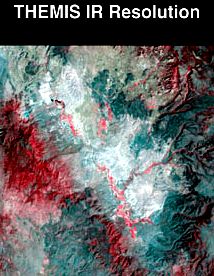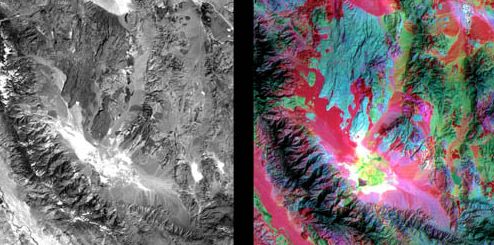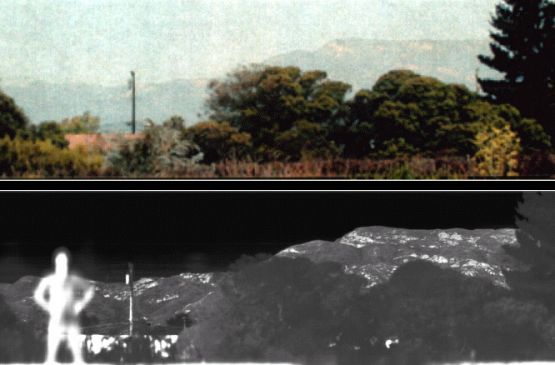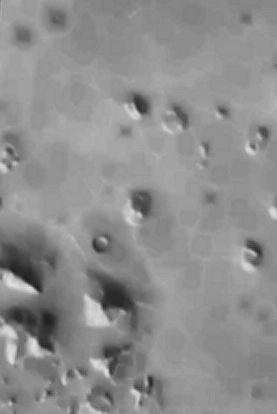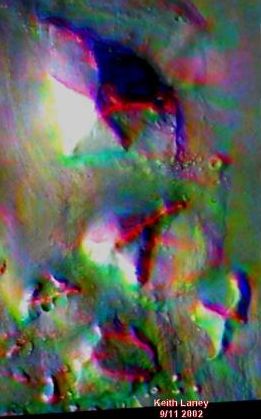Cydonia Quest The Occasional Journal C Entry No.1 - 16th November 2002 The Leaked Cydonia Infrared Image Controversy - Part 1 An appropriate place to begin the Occasional Journal is with an investigation of the leaked Cydonia infra-red (IR) image controversy that has exercised the Enterprise Mission since the late summer. Cydonia Quest does not normally review the image enhancement work published by other Cydonia researchers because the viewer either agrees with the researcher that the subject matter looks somewhat artificial, or they don't. There is no need for this website to provide critiques. However, in the case of this controversy it is the veracity of the leaked image itself that is the issue and not the interpretation of the image contents. I don't want to go into a great deal of detail of how an entirely different version of the first daytime multi-spectral IR image set of Cydonia was downloaded onto Keith Laney's computer by a mystery benefactor. The three links below tell the story better than I can.
|
µµµ The Enterprise Mission's preliminary analysis of the "real" image controversy µµµ "Anatomy of a Bamf" by Mars News.com µµµ Keith Laney tells his own story The nine multi-spectral IR images of Cydonia released on the 24th January 2002 on the Mars Odyssey website (click µµµ) should illustrate one of the amazing features of that spacecraft's THEMIS camera. Basically, materials of different compositions - hard rock or soft dust - or of different mineral make-ups re-radiate the heat of the Sun in different parts of the infra-red spectrum. By taking several images in different parts of the IR spectrum almost simultaneously of the same spot on the Martian surface the THEMIS camera collects very detailed information about an area's geology. The standard way of analysing such multi-spectral IR images is to merge them together using a process called "de-correlation stretch". This gives a false colour to each of the bands in the IR spectrum and then emphasises where patches of the surface have unique IR spectral signatures. It is these unique signatures that will allow detailed mineral maps of Mars to be compiled one day. The images below give an idea of the resolution of the THEMIS camera and provide an example of what de-correlation stretching of multi-spectral IR images can achieve when overlaid onto visible light images. (Both images are of Earth taken by satellites. Readers wanting to know more should click this "stargate" µµµ. For those with fast modems full sized versions of the images can be seen here µµµ and µµµ - images 3.2 megabytes and 2.8 megabytes in size respectively.) cccccccccccccccccccccccccccccccccccc cccccccccccccccc C It wasn't immediately apparent to Keith Laney that he had downloaded an entirely different version of the multi-spectral IR images of Cydonia from everyone else and he was very un-impressed by what he saw in the version he got. (The probable reason why Laney was targeted for the leaked image is that he is the only member of the Cydonia community who processes raw Mars images for NASA - see µµµ). Co-incident with the release of the first daytime IR image of Cydonia the person who had processed the THEMIS images for the Mars Odyssey programme - Noel Gorelick - became a regular contributor to the old Enterprise Mission conference board and chat room using the pseudonym of "Bamf". (The source for "Bamf" can be traced to a cartoon character, an acronym of a very crude phrase.....and web speak for re-directing an unsuspecting internet user to a web page designed just for them in mind). Whilst extolling the virtues of multi-spectral IR imaging, Gorelick constantly tended to downplay the practical value of the 24th July images that he himself had processed and uploaded to the Mars Odyssey website. (As both a participant and spectator to events on the conference board at the time, this was my strong impression of what Gorelick was conveying). He even referred to them as just being "pretty pictures" displayed for demonstration purposes only. Yet despite this disclosure Gorelick had objected earlier to Keith Laney's assertions that the same images where useless, in a strange display of inconsistency. Now Gorelick's conference board persona - "Bamf" - is quite provocative and Laney was challenged to process the multi-spectral images using de-correlation stretch. Laney was not versed in multi-spectral IR image processing and it was only with advice from Noel Gorelick that he was able to quickly master these skills using ENVI 3.5 software, (click "stargate" for details µµµ) . (Note - It has been suggested by some that the Noel Gorelick frequenting the old Enterprise Mission conference board and chat room could be an impostor. However, Mr.Gorelick is well aware of the activities of "Bamf" and after several months has not come forward to denounce him as an impostor). It was at this stage that things got interesting. Laney was able to produce beautiful de-correlation stretch images of Cydonia by mixing different combinations of the IR bands, just like in the previous examples - but he also got something else. The plains areas of Cydonia were everywhere covered with rectilinear grids. Laney was in contact with the Enterprise Mission and it soon became apparent that nobody else could replicate his results - not just the grid pattern, but not even anything that looked like de-correlation stretch images. That's when it became apparent that Laney had downloaded a different image from everybody else. Although the images now available on the Mars Odyssey website look great, each image has too much underlying "noise" to merge in any meaningful way using de-correlation stretch. The Enterprise Mission (TEM) concluded that Laney's image was a leak of actual data from the THEMIS camera by a mission insider and that the multi-spectral image set currently available on the Mars Odyssey website has been deliberately degraded as part of a cover-up to suppress evidence of artificiality on Mars. As a prelude to publicising the de-correlation stretch results from the leaked IR images TEM published the leaked images on its website on the 30th August with the request that interested parties try using de-correlation stretch on the data. Click this "stargate" µµµ to compare the leaked images with the official image set. (TEM had arranged for readers in America and Canada to get a free trial of ENVI 3.5 from its makers). This is when TEM found itself under fire. Firstly, what TEM was now calling the "real" images had less visible detail than the "official" images. TEM explained this by pointing out that because heat is conducted through solid material, even into small shadowy areas, any surface will look more uniform in IR than it does in visible light. Now interestingly I had made the same argument to explain a perceived lack of detail in the "official" version of the images in an analysis that was published on Cydonia Quest on the 31st July, (µµµ). TEM were now claiming that even the "official" image set were showing too much detail for IR images and that these "official" images were actually a hybrid of visible light pictures taken by Mars Odyssey's visible light camera (hence the detail) and degraded IR data. Well it's difficult to say how much detail there should be in daytime IR pictures of the Martian surface. The illustration below compares a scene with an invisible man in it with the same scene taken by the actual THEMIS camera. C CCCCCCCC
C The first thing that becomes apparent is that the invisible man is given away by his own body heat. We can also see the ability of infra-red to cut through atmospheric haze. It is much easier to discern the areas of vegetation and bare rock on the distant hillside than in the visible light image. However, although nearby trees and bushes have a range of leaf colour ranging from yellow to dark green they all look much the same in this image (because leaves are water cooled to an optimum temperature). This is also true for the invisible man or the roof of the building behind him. Only the telegraph pole shows more detail because of the presence of both wood and metal. If the distant hillsides had been completely devoid of vegetation it looks as if they would have been almost one block of white. To my eye both the "official" and "real" versions of the Cydonia IR images released on the 24th July have less detail than would be expected from a comparable visible light image of the same resolution. The image above at least suggests that it is plausible that a genuine IR image of Cydonia would be as lacking in surface detail as the leaked "real" version of the images. The Enterprise Mission's case for a cover-up would be greatly improved if they could find a conclusive piece of evidence to objectively show that there is too much surface detail in the "official" version of the image. The second complaint against the "real" images was that the "look" and certain features (the "blockies") seen in the nine individual IR image bands could be almost replicated by degrading the "official" images in certain ways. The Enterprise Mission's counter argument is that it is difficult to see how the "official" images, which produce a noisy mess when processed with decorrelation stretch, can then go on to produce entirely coherent decorrelation stretched images after they have been degraded. Cydonia Quest has been experimenting with changing the "official" images to look more like the "real" versions and has developed a test for judging how close similar looking images really are. The results of these experiments have led me to conclude that it may not be possible to exactly replicate the "real" images from the "official" images. This would suggest that the "real" images were made from original THEMIS data even if they have undergone some process of "degradation" - and not from the published (and analytically inadequate) "official" image. In other words, in this scenario, it would only have been possible for the "real" images to have been made with data that has not yet been made available to the public. That being said, I do suspect that the "real" images have been subjected to some kind of additional filtering after they were processed. The Cydonia Quest view of the thermal grids seen in decorrelation stretch images of the "real" IR images is that this filtering has created the illusion of grids in parts of the image where they don't exist. However, enhancement of visible light images and of the "official" IR images by Cydonia Quest reveals that thermal grid patterns, corresponding to those derived from the "real" images, do exist in the areas around the "Fort", "Face" and D&M Pyramid. These two articles - µµµ & µµµ - in this website's enhancement section give a preview of the arguments and evidence that will follow in Part Two of this investigation. If both the "official" and "real" versions are not as good as they might be then this raises some interesting possibilities that are touched on below. In Part Two a scenario will be put forward for why this may be the case. The arguments of those who think the "real" image is a total hoax will be analysed in Part Three. The illustration below left shows a portion of the "real" IR image set, with its controversial "blockies". The illustration on the right gives an example of how well decorrelation stretch images derived from the "real" data match the landscape seen in visible light images when overlain onto them. C C Put simply the Enterprise Mission case for the "official" images being a NASA perpetrated "fraud" is that they cannot be used to create coherent decorrelation stretch images like they are supposed to. Secondly, that the range of information differences between the nine "official" IR image bands seems to be strangely muted as if the data range has been deliberately compressed. If NASA was systematically tampering with IR images from the Mars Odyssey then it would be a very dangerous step on the road to perdition for the hypothetical conspirators. There is a precedent for NASA tampering with an image to distract public attention away from Cydonia anomalies. When the first high resolution image of the "Face" from the Mars Global Surveyor was released to the media in April 1998, it had been so thoroughly degraded that all sense of relative depth was lost. This "Catbox" image has caused resentment amongst Cydonia researchers ever since, (click "stargate" for details µµµ). A properly processed version of this "Face" image was only released the next day when the media had lost interest in the story. I think it's possible that when the "official" Cydonia IR images are released onto the Planetary Data System (PDS) website we will find that it will be possible to produce decorrelation stretch images from them similar to those derived from the "real" images. I don't think the individual images will look any more like the "real" image set than the "official" ones do now, but I suspect that decorrelation stretch will reveal some very anomalous thermal grid patterns in the area I've identified above. The Enterprise Mission case for the "real" IR images being a more honest representation of the IR data collected by the THEMIS camera can be seen in the example of the decorrelation stretch image derived from it above. Exposed ridge lines can be seen to be compositionally different from the loose eroded material lying on the lower slopes. The "official" image set cannot produce such coherent effects. The Enterprise Mission's arguments for the veracity of the "real" images will be covered in more detail in Part Four. As Keith Laney was the only person to obtain a copy of the "real" images some people have put forward the obvious hypothesis that the "real" images were created as a hoax by Laney himself using the "official" images released on the 24th July 2002. Now the Enterprise Mission says it can show that the "real" images came to be on Laney's computer hard drive on the 25th July 2002. Only Noel Gorelick knew that the images would be uploaded to the Mars Odyssey website on the 24th. So this would have given Laney only a day (starting from scratch) to somehow alter the "official" images in such a way that they could suddenly produce coherent ENVI processed images like the example given above. It should also be remembered that it was only later that Gorelick was to tutor Laney in multispectral image analysis using decorrelation stretch. Given that in mid November 2002 we have yet to see anyone produce anything like the example image above by degrading the "official" data set, the idea that Laney could have done it in a day seems very unlikely. This in itself is one more piece of evidence that the "real" image set was produced from data that was not available to the public at that time, rather than degraded from the "official" image set published on the 24th July. The Enterprise Mission have described themselves as being "unabashed conspiracy theorists". Cydonia Quest isn't in that mould. However, it seems likely that whether or not the "real" images are a total hoax or a glimpse of the real deal that they originated from within NASA. Some speculation about conspiracy theories is therefore excusable here. There are three main logical possibilities concerning the "real" and "official" images, namely - (1) The "official" version is totally truthful and the "real" version is a lie. As described previously Cydonia Quest's investigation has arrived at a variation combining options two and three. The "real" images are producing decorrelation stretch results that are more useful and "honest" than the "official" ones - but the "real" images have been filtered in such a way that false grid patterns have been created in places where there aren't any in the original data. So why was the "real" image filtered in this way? It must be remembered that we don't entirely know what the "real" images really are or what the motive of the sender was, as they did not arrive with any explanations. It is possible that the images were filtered by somebody to enhance the grid effect evident in the "Face", "Fort" and D&M Pyramid area. This person would have been aware that the false "blockies" that resulted in much of the rest of the image were bogus. If these images were then leaked by a genuine "whistle blower", then they might not have known about the filtering artefacts. There is, however, a more conspiratorial possibility. It was argued above that a strategy by hypothetical conspirators that relied completely on publishing fraudulent images would be very dangerous for them. A cover-up methodology that concentrated on manipulating public relations and that allowed for "plausible deniability" would be cleverer. So, the "official" version of the images seem useless for producing decorrelation stretch images? Well Noel Gorelick has already told us that they are just "pretty pictures" and so hinted by extension that they are not suitable for that purpose. Then an image set is leaked that does produce beautiful decorrelation stretch images, but were the individual images have been filtered in such a way that they produce false "blockies" over every level surface imaginable. As a result real thermal grid effects in the image are hidden in plain sight in a sea of false "blockies" - think of a diamond hidden in a bucket of ice cubes. So why hide the real in with the false? Well most Cydonia researchers almost immediately rejected the filtered appearance of the "real" images because they looked too much like a crude hoax. So now let's imagine that the version of the Cydonia IR multispectral image set that is eventually released onto the PDS is suitable for decorrelation stretching and does reveal some anomalous thermal grids as was suggested earlier. I would suspect that after the hullabaloo and mass rejection surrounding the Enterprise Mission's articles on the "real" images that members of the Cydonia community will be very wary about any claims of the discovery of grids in the PDS images. The media of course won't be taking any notice at all by that stage.........a double "Catbox" strategy anyone? Readers may be interested in visiting Keith Laney's THEMIS infra-red image page, just click µµµ. µ Click this "Stargate" for Part Two µ Click this "Stargate" to return to Journal main page
|
